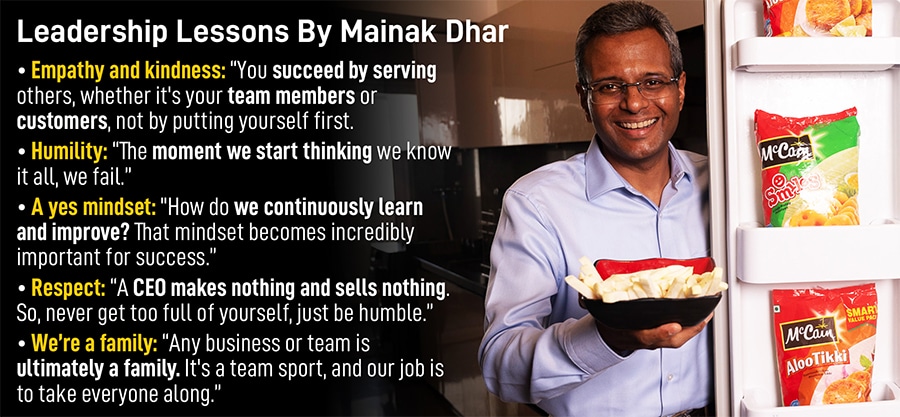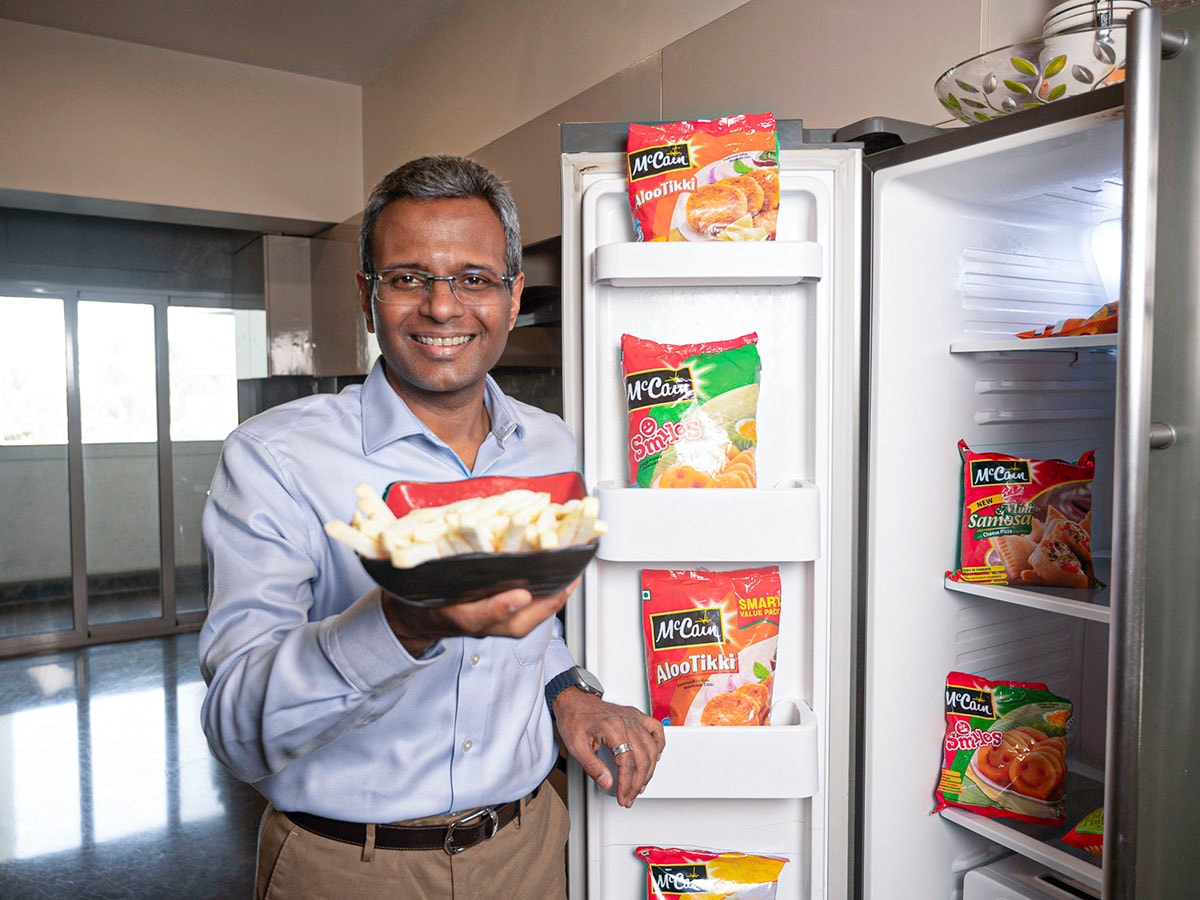The Indian frozen foods market was capped at Rs191 billion in 2024. Between 2025 and 2033, it is expected to grow at a compounded annual growth rate of 13.4 percent and touch Rs593 billion, according to IMARC, a global management consulting firm.
Established in 1957 in Canada, McCain Foods, specialising in frozen potato snacks, entered India in 1998 and now offers a variety of products tailored to Indian tastes. It is currently available in 1,000-plus cities via retail, online platforms, and food services through tie-ups with quick-service restaurants, and large and small hotel chains. Globally, the chain operates in over 160 cities and has 49 plants.
Forbes India caught up with Mainak Dhar, managing director of McCain Foods India, in his first interview since assuming the role in August 2024. He discusses strategies to navigate the competitive and price-sensitive Indian market, plans to expand to more Tier II and III cities along with the company’s commitment to sustainability, and more. Edited excerpts:
I look at frozen food as just a format in which people consume food or snack. According to me, the Indian market for snacking is what we’re bullish about due to several factors.
First, we have a young population—with nearly 50 percent under the age of 30—that is more open to adopting new food trends and experimenting with different cuisines. Second, the Indian habit of how, where and when they consume food is radically changing. With food delivery and quick commerce, there is a huge boom in snacking. Frozen food gives you the convenience of serving hot and made-at-home food, feeding into the homemade aspect. Third, technological advancements are also helping drive growth with improved cold chain infrastructure, enhancing the quality and availability of frozen foods.
Q. What challenges did McCain Foods face after entering the Indian market? Are there any ongoing hurdles that the company continues to face?
One of the things that one might say could have been a challenge, but the previous generations had the foresight to invest in, is the farm-to-fork model, to ensure a consistent supply of quality raw material. Another initial challenge was establishing a cold chain. We built some of it ourselves, and for the rest, we partnered with customers. Currently, as the Indian market and the customer continues to evolve, our focus is to find new ways of serving them. For instance, the latest addition to the McCain portfolio was the SureCrisp fries, which stay crispy longer, besides introducing the aloo tikki, or mini samosas, the veggie burger patty, and more. I don’t see this as a challenge but as a responsibility to find new ways to serve consumers.
Q. Many consumer habits have changed, especially after the pandemic. Has that been a challenge?
Whenever we’re talking of consumers, it’s never a threat or a challenge. It’s a need to be met. As a company, what’s important is we are not reacting to a trend, like changing dietary habits but thinking of how we can partner with customers and accompany them on their journey. We’ve taken steps to make our products preservative-free, reduced the sodium content by 15 percent, and provide clear and transparent nutritional information. We want to continue to think of guilt-free options and most importantly, stay a family brand.

Q. How has McCain Foods India performed in recent years, especially in a price-sensitive and competitive market like India?
We are on a consistent growth trajectory, and we view India as one of the core markets to invest in. We are aware that it is a price-sensitive market, and its diversity means there’s no singular market. While the metro cities are quite developed in terms of access and awareness of trends, we’re seeing growth in terms of aspiration and disposable incomes in Tier II and III cities too. We don’t want to be a brand that serves only one segment. We want to premiumise and offer snacks that are aspirational. At the same time, we want to continue offering good value. Our job will be to continue working with customers at the top tier who drive innovation and global trends and, at the same time, expand accessibility and availability in smaller towns.
Q. Are there plans to expand to Tier II and III cities?
We have a significant presence in Tier II and III cities, especially in our food service business where we work with large and small food service operators and restaurant chains. The intention is to expand our presence further over the next few years into the smaller towns, especially with our quick service restaurant segment, where we align with partners such as McDonald’s, KFC and Burger King, who are also seeing immense growth in these cities.
Also read: HyFun Foods: Meet the Indian company making fries for Burger King, KFC
Q. There has been a growth in competitors in the domestic market with products such as ITC’s Master Chef, or Godrej Yummiez. How does McCain differentiate itself and what are the strategies to stay ahead of the increasing competition?
I don’t think the question we should ask is how do we stay ahead because competition is a good thing. More options for consumers only help grow the category. Our category is still relatively underdeveloped, with low penetration. Therefore, more players help build the infrastructure… the overall pie grows, and everyone can have a share in it. Second, we need to focus on being customer-obsessed. That includes meeting their needs better than others. Moreover, the important questions to ask are how can we continue to refresh our brand which already has a strong resonance, and how we can continue to innovate. If these are done right, the outcome will be growth in sales and share. If we continue to focus on the consumer, the rest will follow.
Q. Sustainability is a growing concern. What are the sustainable practices that McCain India has adopted?
We are as close and grounded to the earth as possible. It starts with smart and sustainable farming. We are looking at progressively implementing regenerative agriculture procedures such as water recycling and getting more stress-tolerant varieties of potatoes. We are trying to educate growers about sustainable farming practices, which will also help them tap more yields. We have committed to a 50 percent absolute reduction in greenhouse emissions by 2030, using 100 percent renewable electricity by 2030, and zero waste to landfill by next year.
Our manufacturing facility is located in Mehsana, Gujarat. Over time, as we’ve started looking at diversifying the variety of potatoes, we have started expanding into some other geographies.
At a global level, there is research being done on the impact of climate change in different geographies. We do tap into that intelligence from our agriculture team and scientists on the areas we operate in. That gives us an insight into the variety of seeds we should start building a pipeline on.
 Mainak Dhar, managing director, McCain Foods India. Image: Swapnil Sakhare for Forbes India
Mainak Dhar, managing director, McCain Foods India. Image: Swapnil Sakhare for Forbes India 
